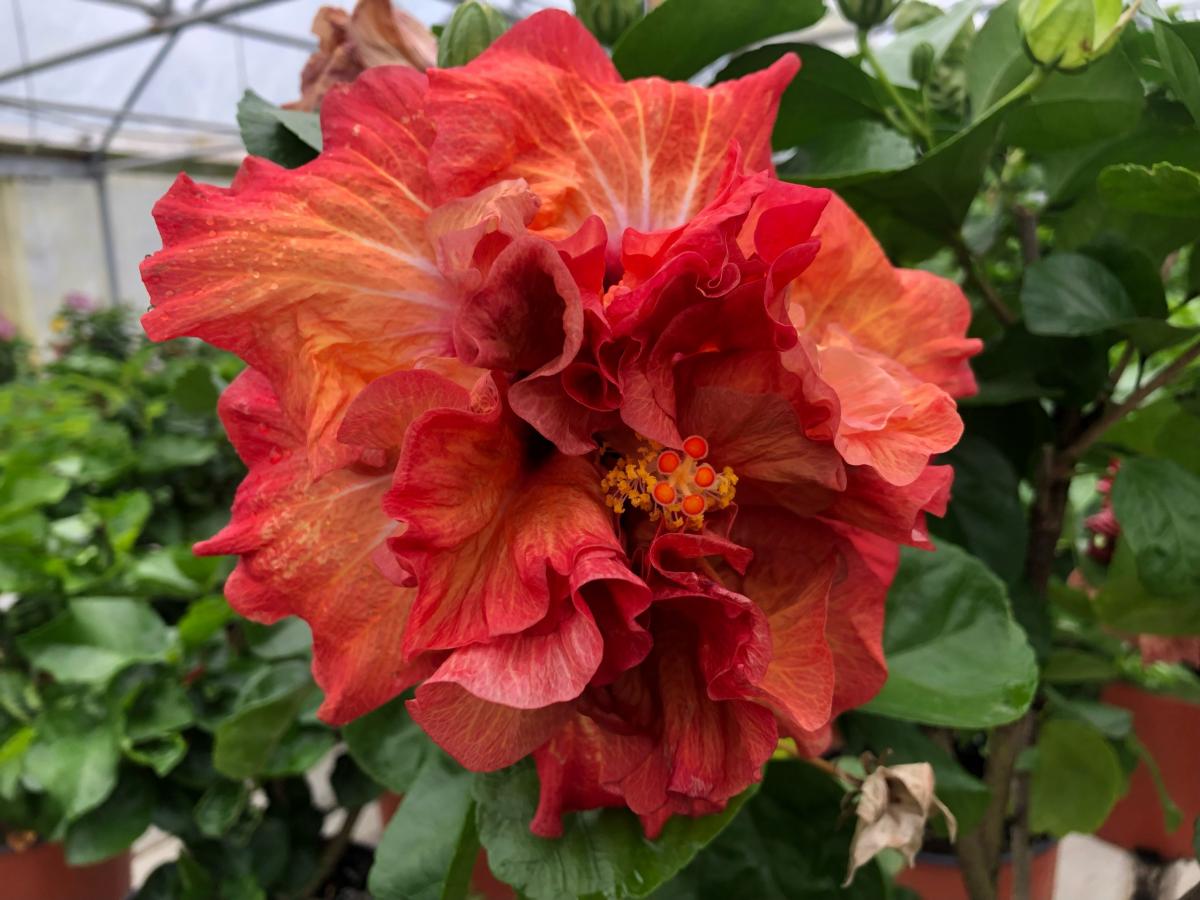1
/
of
1
Hibiscus Koki - Cajun Hibiscus
Hibiscus Koki - Cajun Hibiscus
Cajun hibiscus is a cultivar developed by breeder Robert Dupont in Plaquemines, Louisiana.
Container Size: Trade Gallon
Photo Credit: Dupont Nursery
General Growing Instructions for Hibiscus Rosa-Sinensis (Taken from the Dupont Nursery website)
This information is made available through the website of the New Orleans Chapter of the American Hibiscus Society. The information and the website is credited to Father Robert Gerlich.
INTRODUCTION:
Watering
Hibiscus like “even” watering. Don’t let your hibiscus get too dry or stay too wet. If dried out for too long, the plant can drop its leaves or even go into shock and die, despite renewed watering. If overwatered, especially in pots, fungal disease can destroy the root system, or the soil can pack and deprive the roots of needed oxygen. In short, Do NOT water plants if they are still wet.
In summer, when the plants are in active growth, they require more water. While not all cultivars enjoy the same amount of water or tolerate the same amount of dryness, hibiscus in general like being well watered, especially in hot weather. Even so, hibiscus do not like to be continually wet, as this promotes fungal disease and packs the soil, robbing it of vital oxygen. Do not leave them sitting in saucers full of water for too long. If possible, water in the mornings and let the plants dry out over the course of the day.
During cooler periods of the year, water more sparingly. In winter, when the plants are NOT in active growth, water only when the plant is dry. Cool moist conditions are ideal for fungal diseases, and one must be careful NOT to create those conditions.
Occasionally, plants will lose all their leaves. This is either a reaction to stress or the natural process of renewing its foliage for a different season. When plants are without leaves, there is relatively little transpiration and it may be days before they need watering again. Overwatering now can cause “root rot.”
Fertilizing
Fertilize light but often. Hibiscus in active growth are heavy feeders, especially when planted in pots. Some growers fertilize every time they water, in which case they use a diluted, water-soluble fertilizer solution at less than full strength.
Apply fertilizers in the cooler hours of the day, and be sure to water well before applying any granular fertilizer. Be especially careful to keep the plants well-watered after using any granular fertilizer.
The prevailing opinion is that hibiscus do not need (nor want) high amounts of Phosphorus (P, the middle number), but they do demand high quantities of Potassium (K, the last number). Tropical hibiscus fertilizers have ratio numbers like 9-3-13, 10-4-12, and 12-4-18.
Granular fertilizers have the advantage of providing plants with a constant source of nutrients. But some, even those marked hibiscus fertilizer are prone to burn the roots of the plants, especially if the plant is potted and becomes too dry. Moreover, these fertilizers break down unevenly, depending on temperature. The hotter the temperatures, the faster the granular fertilizer breaks down (despite label assurances). Some growers place a layer of mulch over the granular fertilizer to slow its rate of break down during the hot summer months.
For large hibiscus in the ground, it is easier to keep them consistently fertilized by placing “tree stakes” around the shrub/tree during the early spring. Since stakes for hibiscus are not available, I use stakes designed for palm trees. I have found that these formulas generally match those of hibiscus fertilizers very closely.
Remember: Phosphorus buildup or pH unbalance account for some 95% of the cases of slow decline and eventual death in hibiscus. Phosphorus, the “P” in the N.P.K formula, affects bloom quality and quantity, but hibiscus only need a small amount, since hibiscus “store” phosphorus. Excessive phosphorus will bind up other minerals. The effect can prove toxic to the plant.
Bud Drop
Notice buds dropping excessively? “Bud Drop” is a sign of stress. It is occasionally a problem, especially with double-blooming varieties, during excessively hot weather. Some hibiscus cultivars are more sensitive to heat and seem to drop buds almost naturally under these conditions. Hibiscus grow best in daytime temperatures ranging between 75 and 85 degrees Fahrenheit.
Not all “bud drop” is caused by excessive heat. Any stressful condition can prompt the plant to drop its buds. In many cases the cause is one of the following: lack of water, too much water, wind, heavy rain, insects (especially: hibiscus midges or thrips) and/or an unbalanced feeding formula. Try moving the plant into a more shaded area and regulate the watering more closely.
Light & Temperature
Some of the new cultivars are grown very successfully in light shade. Potted hibiscus enjoy some protection from our intense, summer sun. A pool/shade screen, providing 25% shade, offers blessed relieve during the hottest part of the summer day and helps prevent stressing the plants, especially those planted in black, plastic pots. Lighter colored pots help prevent the roots from overheating.
Many growers recommend a good layer of compost once a year. If that cannot be done, meet your plants’ needs with good soil porosity and an adequate fertilizer formula.
Hibiscus can normally withstand a light freeze. But if the weather is windy, temperatures as high as 45 degrees can still produce damage. How much cold a plant can tolerate depends on exposure, wind strength, length of cold, available moisture and slight differences in cultivar tolerances.
Hibiscus need real daylight to bloom. During the winter months, they enjoy full sun all day and will bloom beautifully as long as the temperatures remain mild. A slow down in bloom production and a decrease in blossom size will be noticeable once the evening temperatures drop regularly below 55 degrees Fahrenheit.
Insects
Do not use Malathion liquid to control insects. The oil “carrier” in Malathion will cause the leaves to drop and may even kill the plant. WP (Wettable Power) Malathion is fine. Most insect problems (aphids, spider mites) are best handled by spraying underneath the plant’s leaves with a hard stream of water at relatively close range. Careful observation and persistence are necessary to keep the insects at bay.
To control severe infestations of mites and/or whitefly, soap sprays are recommended. Use Insecticidal Soap according to the label. Use Palmolive or Dawn or Sunlight soap at one to two tbs. per gallon to smother the insects on the plants. If you need to use more than 2 tbsp/gal, remember to later rinse off the plant. Spray twice a week until bugs are gone.
There are occasions when chemical sprays seem to be the only way to stop a major infestation. Should you choose to use chemicals, follow directions carefully and use with caution. Although few insecticides injure hibiscus, it is always good to read labels and to see if the product is recommended for hibiscus.
Spray your plants in the evening after the heat of the day or very early in the morning. This applies to both using insecticides or foliar feeding. There is less danger this way of burning the leaves.
Repotting
There is no easy “rule of thumb” for deciding when a plant should be repotted. Some growers routinely repot every year; others every other year. However, it is really the plant that decides when to repot. If it becomes lethargic, take a good look at the soil mix. It may have “broken down” and lost porosity. Rework the soil or repot. Should the roots be pressing hard against the pot, it is time to repot.
When repotting, move the plant up to the next size pot rather than putting a small plant into an oversized pot. Instead of potting up, another solution is to and prune the roots and the top of the plant (about 1/3 of each) and then return the plant to its original pot. Water moderately until the root system is well established.
Plants that are newly potted up should be watered well, but NOT soaked. Unlike established plants that need thorough watering, newly planted hibiscus need to be encouraged to seek out moisture at the bottom of the pots. Overwatering while a plant is still “filling” in the pot with its root system will encourage root rot and discourage deep root growth. Judicious bottom watering is a good way to avoid this problem.
Regular price
$25.00 USD
Regular price
Sale price
$25.00 USD
Unit price
/
per
Shipping calculated at checkout.
Couldn't load pickup availability


